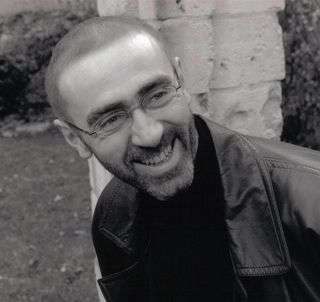|
Back
A Fascinating and Interesting Evening Hong Kong
Hong Kong Cultural Center Concert Hall
05/02/2010 - & May 3
Fryderyk Chopin: Nocturnes Op.9 No.1, Op.55 No.2 & Op.15 No.1 – Andante spianato et Grande Polonaise brillante Op.22 (*)
Gabriel Fauré: Nocturne No. 6 in D-flat major, Op. 63
Maurice Ravel: Gaspard de la nuit
Hector Berlioz: Symphonie Fantastique (Version for piano transcribed by Franz Liszt) (*)
Gabriele Carcano & Roger Muraro (*) (Piano) 
G. Carcano
The two concerts of “Chopin and the French Composers” were planned to invite pianists from three generations – Aldo Ciccolini, Roger Muraro, and Gabriele Carcano. But the withdrawal of the most renowned one among the three – Ciccolini – must have brought disappointment to many fans who bought the tickets. Fortunately, for those whose lofty expectation was thwarted, they could experience a wonderful evening by hearing the consummate piano playing of the two remaining pianists.
The recital was divided into two parts, with the first half played by Mr. Carcano and the second by Mr. Muraro. Mr. Carcano raised the curtain with an engrossing reading of three of Chopin’s Nocturnes. He was natively attuned to the poetic language of the composer by rendering with a milky and singing tone. The vaporous pianissimo in the B-flat minor Nocturne, cantabile melodies in the F major, and crystalline articulation in the E-flat major are all telling exemplifications of his innate poetic insight. I can imagine the refinement he possessed would have sounded more cogent in an intimate salon, a setting that Chopin himself preferred to perform. The following Nocturne by Fauré was also an absolute delight brimming with charm and imagination.
Ravel’s Gaspard de la nuit gave room for the young Italian to demonstrate his nimble fingers. The dreamy sonority at the opening and elsewhere was delivered with utmost lightness and cleanness. Under his nimble fingers Mr. Carcano transformed every note into arching lines of a coloristic delineation. Throughout, the music was enshrined in a sense of delusion and myth that gave the audience ample space to imagine their own versions of the story. But the price he paid was the lack of febrile sparks at the end of the last movement. With a relatively sluggish pace, the whole piece somehow went by as a hallucination without climax.

R. Muraro (© Marion Kalter)
Roger Muraro in the second half also began with Chopin, this time not a Nocturne but the Andante spianato et Grande Polonaise brillante. The opening was a spontaneous account with improvisatory ebbs and flows. Though it sounded a little too hastening and casual, this was authentically acceptable and appropriate to the function of the work (the Andante spianato was indeed composed five years later as an ‘improvised prelude’ to the succeeding Polonaise). But for the Polonaise, composed during Chopin’s early Warsaw period, the hastening and tarrying rubato and dramatic harmonic change Mr. Muraro adopted in some way turned the Polish heroic dance into a French salon tune, for he showed more interest in mining the music’s melodic and harmonic charm rather than its rhythmic pulse.
Notwithstanding, it was impossible not to admire Mr. Muraro’s audacity in choosing the Liszt’s transcription of Berlioz’s Symphonie Fantastique in his program. Technically, it was a piece no easier than the B minor Sonata by Liszt himself; musically, it is of immense challenge to bring to life all Berlioz’s envisaged musical effects by merely ten fingers, especially when the piece was composed for a massive orchestra with more than a hundred players. Berlioz is perhaps the composer who is most prominent for the technique of instrumentation and orchestration. Liszt’s transcription by no means loses the paramount ingredient – coloristic effects of different instruments – of the work, though it retained most of the original elements and ideas. It would be more comfortable for our ears if we treat it as a virtuosic piano work rather than a transcription of an orchestral masterpiece. Pianist Mr. Muraro also took the perspective by playing the work in a very pianistic approach. The scurrying filigrees were rendered with harm-blurring speed and glittering tone without compromising the orchestral sonority and some underlying inner voices that are usually indiscernible in the orchestral version. There was one very interesting accident during the last movement. When the left hand was imitating the bells and playing heavy octaves evoking the sonority of tubas, one of the strings at the bass register was broken. Mr. Muraro was forced to took the broken string out and re-started the movement at an appropriate place. This was supposed to be very disturbing and irritating. But it made me laugh when I thought of this being a regular ‘practice’ of Liszt himself as the performer (Liszt is famous for breaking the strings of pianos). By the end of the recital, Mr. Muraro was able to finish the piece without being hindered by the prior accident. Upon audience’s enthusiastic applause, Mr. Muraro delivered Chopin’s well-known C-sharp minor Nocturne (published posthumously) to round up the fascinating and interesting recital.
We are thankful to the Le French May for bringing two consummate pianists onto the stage of Cultural Center. However, the lack of program notes and careless typos in the leaflet are something deserve attention and improvement in their future events.
Le French May’s Website
Danny Kim-Nam Hui
|